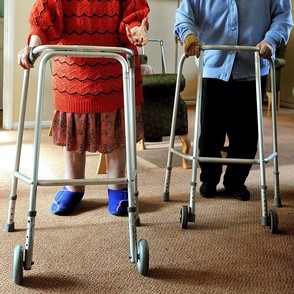SARC-F: A Simple Questionnaire to Rapidly Diagnose Sarcopenia: Difference between revisions
No edit summary |
Kim Jackson (talk | contribs) (Updated categories) |
||
| (3 intermediate revisions by one other user not shown) | |||
| Line 1: | Line 1: | ||
<div class="editorbox"> | <div class="editorbox"> | ||
'''Original Editor '''- [[User: | '''Original Editor '''- [[User:Lucinda hampton|Lucinda hampton]] | ||
'''Top Contributors''' - {{Special:Contributors/{{FULLPAGENAME}}}} | '''Top Contributors''' - {{Special:Contributors/{{FULLPAGENAME}}}} | ||
</div> | </div> | ||
== Introduction == | == Introduction == | ||
[[File:Nursing Home.jpg|right|frameless]] | |||
Strength, assistance with walking, rising from a chair, climbing stairs, and falls (SARC-F) questionnaire: | |||
== | The SARC-F questionnaire is a screening tool that can be rapidly implemented by clinicians to identify probable [[Sarcopenia|sarcopenic]] patients. The questionnaire screens patients for self-reported signs suggestive of sarcopenia, which include deficiencies in strength, walking, [[Five Times Sit to Stand Test|rising from a chair]], climbing stairs, and experiencing [[Falls|falls.]] Each of the self-reported parameters receives a minimum and maximum score of 0 and 2, respectively, with the greatest maximum SARC-F score being 10.<ref name=":0">Ardeljan AD, Hurezeanu R. [https://www.ncbi.nlm.nih.gov/books/NBK560813/ Sarcopenia]. StatPearls [Internet]. 2020 Jul 10. Available from:https://www.ncbi.nlm.nih.gov/books/NBK560813/ (accessed 9.3.2021)</ref> | ||
== Implementation == | |||
SARC-F Screen for Sarcopenia: Component Question Scoring | SARC-F Screen for Sarcopenia: Component Question Scoring | ||
| Line 27: | Line 31: | ||
Falls: How many times have you fallen in the past year? | Falls: How many times have you fallen in the past year? | ||
* None 0 | * None 0 | ||
* | * 1ess than 3 falls 1 | ||
* 4 or more falls 2<ref>Malmstrom TK, Morley JE. [https://www.researchgate.net/publication/243966215_SARC-F_A_Simple_Questionnaire_to_Rapidly_Diagnose_Sarcopenia SARC-F: a simple questionnaire to rapidly diagnose sarcopenia.] Journal of the American Medical Directors Association. 2013 Aug 1;14(8):531-2.Available from: https://www.researchgate.net/publication/243966215_SARC-F_A_Simple_Questionnaire_to_Rapidly_Diagnose_Sarcopenia (accessed 10.3.2021)</ref> | * 4 or more falls 2<ref>Malmstrom TK, Morley JE. [https://www.researchgate.net/publication/243966215_SARC-F_A_Simple_Questionnaire_to_Rapidly_Diagnose_Sarcopenia SARC-F: a simple questionnaire to rapidly diagnose sarcopenia.] Journal of the American Medical Directors Association. 2013 Aug 1;14(8):531-2.Available from: https://www.researchgate.net/publication/243966215_SARC-F_A_Simple_Questionnaire_to_Rapidly_Diagnose_Sarcopenia (accessed 10.3.2021)</ref> | ||
Data suggests that a SARC-F score of ≥4 best predicts the need for further, more comprehensive evaluation<ref name=":0" /> | |||
== | == Validity == | ||
The SARC-F proved internally consistent and valid for detecting persons at risk for adverse outcomes from sarcopenia in AAH, BLSA, and NHANES.<ref>Malmstrom TK, Miller DK, Simonsick EM, Ferrucci L, Morley JE. [https://pubmed.ncbi.nlm.nih.gov/27066316/ SARC‐F: a symptom score to predict persons with sarcopenia at risk for poor functional outcomes.] Journal of cachexia, sarcopenia and muscle. 2016 Mar;7(1):28-36.Available from:https://pubmed.ncbi.nlm.nih.gov/27066316/ (accessed 10.3.2021)</ref> | |||
== References == | == References == | ||
<references /> | <references /> | ||
[[Category:Outcome Measures]] | |||
[[Category:Older People/Geriatrics]] | |||
[[Category:Muscles]] | |||
[[Category:Falls]] | |||
[[Category:Older People/Geriatrics - Outcome Measures]] | |||
Latest revision as of 19:55, 12 March 2021
Original Editor - Lucinda hampton
Top Contributors - Lucinda hampton and Kim Jackson
Introduction[edit | edit source]
Strength, assistance with walking, rising from a chair, climbing stairs, and falls (SARC-F) questionnaire:
The SARC-F questionnaire is a screening tool that can be rapidly implemented by clinicians to identify probable sarcopenic patients. The questionnaire screens patients for self-reported signs suggestive of sarcopenia, which include deficiencies in strength, walking, rising from a chair, climbing stairs, and experiencing falls. Each of the self-reported parameters receives a minimum and maximum score of 0 and 2, respectively, with the greatest maximum SARC-F score being 10.[1]
Implementation[edit | edit source]
SARC-F Screen for Sarcopenia: Component Question Scoring
Strength: How much difficulty do you have in lifting and carrying 10 pounds?
- None 0
- Some 1
- A lot or unable 2
Assistance in walking: How much difficulty do you have walking across a room?
- None 0
- Some 1
- A lot, use aids, or unable 2
Rise from a chair: How much difficulty do you have transferring from a chair or bed?
- None 0
- Some 1
- A lot or unable without help 2
Climb stairs: How much difficulty do you have climbing a flight of 10 stairs?
- None 0
- Some 1
- A lot or unable 2
Falls: How many times have you fallen in the past year?
- None 0
- 1ess than 3 falls 1
- 4 or more falls 2[2]
Data suggests that a SARC-F score of ≥4 best predicts the need for further, more comprehensive evaluation[1]
Validity[edit | edit source]
The SARC-F proved internally consistent and valid for detecting persons at risk for adverse outcomes from sarcopenia in AAH, BLSA, and NHANES.[3]
References[edit | edit source]
- ↑ 1.0 1.1 Ardeljan AD, Hurezeanu R. Sarcopenia. StatPearls [Internet]. 2020 Jul 10. Available from:https://www.ncbi.nlm.nih.gov/books/NBK560813/ (accessed 9.3.2021)
- ↑ Malmstrom TK, Morley JE. SARC-F: a simple questionnaire to rapidly diagnose sarcopenia. Journal of the American Medical Directors Association. 2013 Aug 1;14(8):531-2.Available from: https://www.researchgate.net/publication/243966215_SARC-F_A_Simple_Questionnaire_to_Rapidly_Diagnose_Sarcopenia (accessed 10.3.2021)
- ↑ Malmstrom TK, Miller DK, Simonsick EM, Ferrucci L, Morley JE. SARC‐F: a symptom score to predict persons with sarcopenia at risk for poor functional outcomes. Journal of cachexia, sarcopenia and muscle. 2016 Mar;7(1):28-36.Available from:https://pubmed.ncbi.nlm.nih.gov/27066316/ (accessed 10.3.2021)







